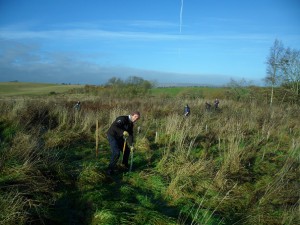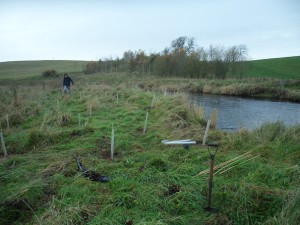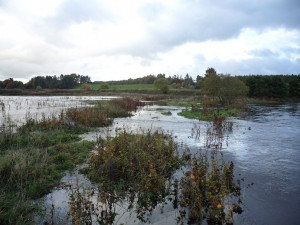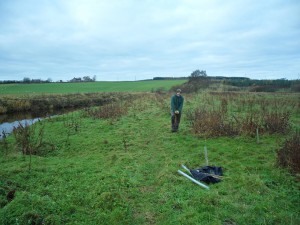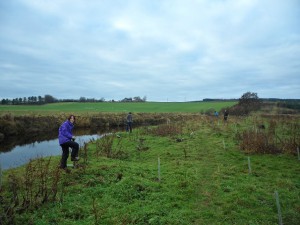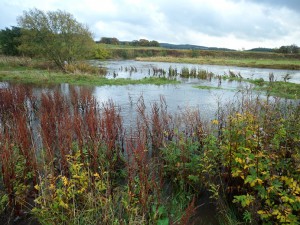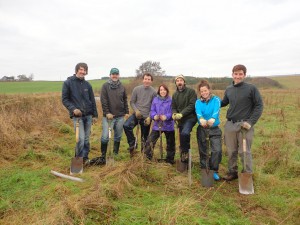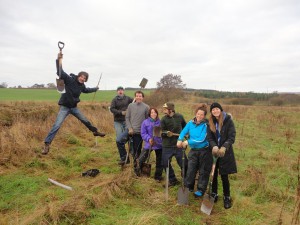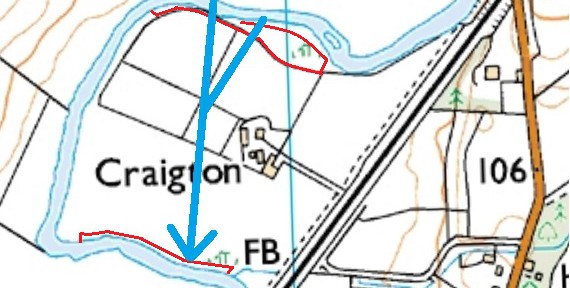
Over the past couple of weeks I have been working on a site called Craigton Farm on the Allan Water Catchment. The landowner of Craigton has a vision that she shares with the Natural Flood Management Project of creating a native woodland on her land beside the Allan Water river. The area where land and water interact beside a river is known as the riparian zone and is characterised by a type of woodland where wetland species predominate. Native riparian woodland is fantastic for biodiversity, fisheries, the natural landscape, recreation, and also minimising flood risk by slowing the flow of flood water. A demonstration of how effective riparian trees are at slowing water can be seen in this video I took during a high water event about a month ago at Craigton (click here).
With our shared vision I started applying for tree grants that would create a native riparian woodland and provide all these benefits. Thankfully, the application was successful and the Craigton Farm Community Volunteers Group were awarded 420 wetland tree species through the Woodland Trust’s Free Tree Scheme. This allowed us to restore native riparian woodland on the site! The farm currently have a small community present where local individuals have permission to use parts of the farm in a variety of different ways. In addition, there is a core path that connects the two nearby villages of Kinbuck and Ashfield, and the area is a fond site for local walkers and fishermen. Therefore renaturalisation of this site has local community benefits, as well as contributing to minimising flood risk downstream.
So the next stage after receiving the good news was to organise how to get these trees planted! Over the summer months I had a stall at local agricultural shows and highland games in the catchment, which allowed me to develop a local Natural Flood Management volunteer base. The volunteers thankfully, were still willing and responsive to my plea for help when it went out. The plan of action for the site was to concentrate the planting where water comes onto the land and flows off it. This would slow the passage of water across the land, allow the land to hold more water, and slow in-channel flow when the trees are established due to their branches and roots entering the channel.
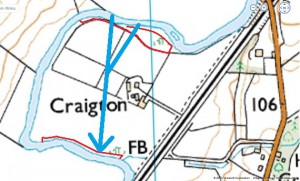
Craigton Farm riparian tree planting site. The large blue line and arrow shows where the flood water comes across the land and the direction of its travel. The red line is the outline of where the 420 trees were planted to slow the flow of water across the land.
The first weekend of planting was on the 17th of November, and involved 10 local volunteers planting on the upstream (top of graphic) planting area in the above map. TCV’s Volunteer Development Officer Ali Lawson accompanied me that day, and provided the demonstration for planting a tree correctly, which included a cane and a tree guard to protect the trees from voles. Following on from that, I then shared the vision for the day, which was to create a natural riparian woodland, which meant that planting density should be randomised and straight line planting avoided. Leaving some open areas within the planting area was emphasised also, as it is important for creating a natural looking woodland, and great for biodiversity and wildlife. After the guiding image was set, it was time for all of us to go and enjoy our day becoming woodland designers!
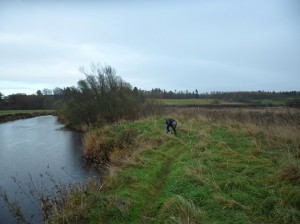
Local resident George planting new trees that will hopefully join into the established woodland in the background over the coming years
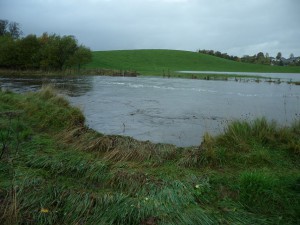
Evidence of where the river bank had been overtopped by flood water a month previous to the planting
By the end of the day the NFM volunteers had managed to plant 300 trees, which was fantastic and left us with only 120 trees left to plant. So we reorganised to plant the remaining trees the following weekend on Sunday the 24th of November. The remaining trees were to be planted on the downstream planting site (bottom of graphic) on the map near the top of the page. The downstream planting site is where the water flows off the land, so riparian woodland here will slow the flow, whilst also holding water on the land. Click here to see a video of this area under high water a month ago. Thankfully, we had another good turn out of 8 local volunteers on the frosty Sunday morning, and after giving a planting demonstration and setting the guiding image, we all just wanted to get stuck into planting some trees and have some fun! Here are some photos from the day.
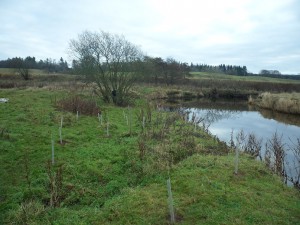
Completed tree planting on the downstream site that floods, note the same tree in the picture as the photo above
The NFM volunteers once again lived up to their excellent reputation, and planted the remaining trees before lunch! Therefore all 420 of the Woodland Trust’s free trees have now been planted at this site, and will provide a variety of benefits, in addition to minimising flood risk as the trees establish. I would like to say a huge thank you to all the NFM volunteers that sacrificed a day or two of their weekends to plant these trees. I would also like to thank fellow TCV apprentice Noelia for allowing me to use her group photographs of the NFM volunteers. I hope everyone involved in this project and the local communities will take great delight, benefit and enjoyment from watching these trees establish over the coming years. I for one, cannot wait to see this site in 5 years time!

